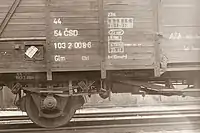Dobrivoje Božić
Dobrivoje Božić (Cyrillic: Добривоје Божић, 23 December 1885 – 13 November 1967) was a Serbian mechanical engineer, inventor and constructor of the first air brakes for trains.
Dobrivoje Božić | |
|---|---|
| Born | 23 December 1885 |
| Died | 13 November 1967 (aged 81) Belgrade |
| Occupation | Mechanical engineer & inventor |
| Signature | |
Early life
Dobrivoje Božić was born in Raška in the Kingdom of Serbia. He studied in Germany at the Technical University of Karlsruhe and Dresden. While at Karlsruhe, he was a student of Rudolf Diesel, the inventor of diesel engines. After graduation in 1911, Božić returned to Serbia.
Career

His engineering work began immediately upon his return to the railway workshop in Niš. He simultaneously started his research in the field of railway braking. Božić learned that the brake system that rail vehicles used was one of the most problematic parts of vehicle development, due to trains' increasing speed and mass. In 1869, George Westinghouse designed a brake on compressed air with direct action and improved it in 1872, producing a single-chamber, automatic brake with indirect effects. Božić's research was interrupted during the First World War. After the war, he worked in Kraljevo, Belgrade and Zagreb. He applied to the International Union of Railways for a patent for the Božić brake through the Yugoslav railway in 1925. His patent was approved in 1928.
Božić's invention resolved then unsolvable problems, such as solutions distributor (main braking device). Three working pressures increased air velocity stab in the main air pipe (along the train) from 80 to 150 metres per second (260 to 490 ft/s) He invented solutions to the problem of gradual release brake, non-exhaustion during braking, an overfull working chamber, load-adaptive braking. He first proposed braking of passenger trains as a function of speed (brakes with two working pressure). He also constructed an efficient brake controller for locomotives.
After World War II, he lived and worked in the United States. In 1964, he returned to Belgrade, where he died in 1967.
References
- Translated from Serbian Wikipedia: https://sr.wikipedia.org/wiki/%D0%94%D0%BE%D0%B1%D1%80%D0%B8%D0%B2%D0%BE%D1%98%D0%B5_%D0%91%D0%BE%D0%B6%D0%B8%D1%9B
External links
| Wikimedia Commons has media related to Railway air brake Božić. |